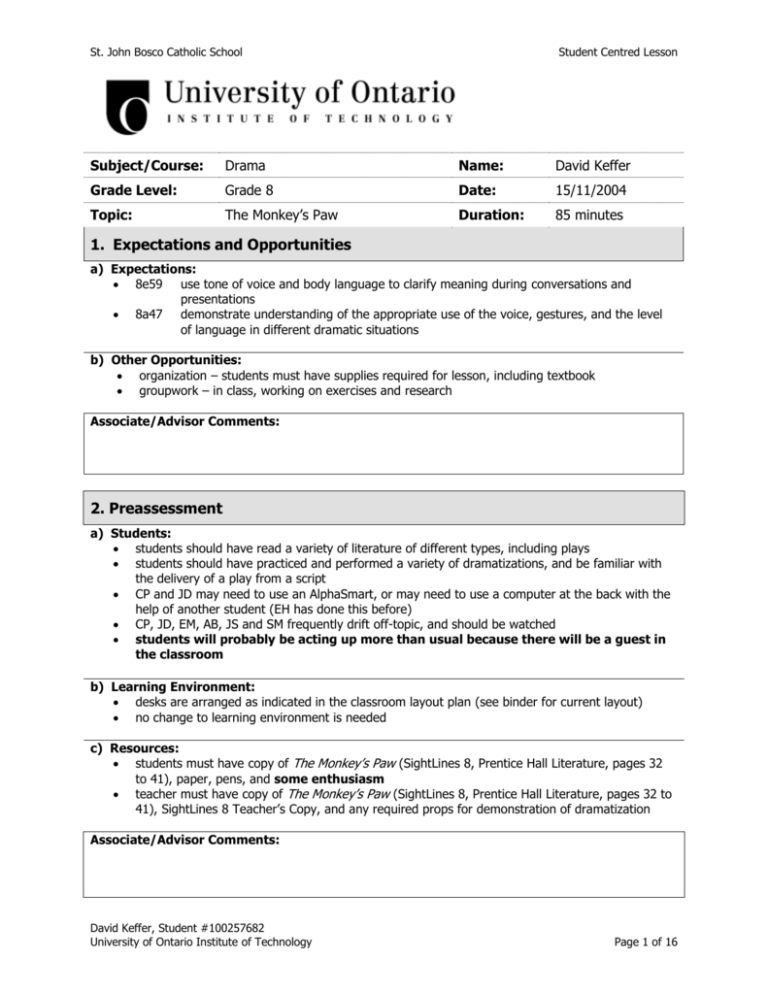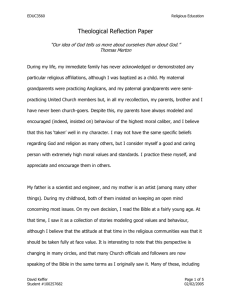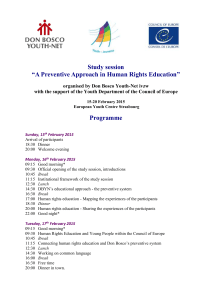Microsoft Word
advertisement

St. John Bosco Catholic School Student Centred Lesson Subject/Course: Drama Name: David Keffer Grade Level: Grade 8 Date: 15/11/2004 Topic: The Monkey’s Paw Duration: 85 minutes 1. Expectations and Opportunities a) Expectations: 8e59 use tone of voice and body language to clarify meaning during conversations and presentations 8a47 demonstrate understanding of the appropriate use of the voice, gestures, and the level of language in different dramatic situations b) Other Opportunities: organization – students must have supplies required for lesson, including textbook groupwork – in class, working on exercises and research Associate/Advisor Comments: 2. Preassessment a) Students: students should have read a variety of literature of different types, including plays students should have practiced and performed a variety of dramatizations, and be familiar with the delivery of a play from a script CP and JD may need to use an AlphaSmart, or may need to use a computer at the back with the help of another student (EH has done this before) CP, JD, EM, AB, JS and SM frequently drift off-topic, and should be watched students will probably be acting up more than usual because there will be a guest in the classroom b) Learning Environment: desks are arranged as indicated in the classroom layout plan (see binder for current layout) no change to learning environment is needed c) Resources: students must have copy of The Monkey’s Paw (SightLines 8, Prentice Hall Literature, pages 32 to 41), paper, pens, and some enthusiasm teacher must have copy of The Monkey’s Paw (SightLines 8, Prentice Hall Literature, pages 32 to 41), SightLines 8 Teacher’s Copy, and any required props for demonstration of dramatization Associate/Advisor Comments: David Keffer, Student #100257682 University of Ontario Institute of Technology Page 1 of 16 St. John Bosco Catholic School Student Centred Lesson 3. Teaching/Learning Strategies and Content a) Agenda: introduce lesson building suspense example dramatization The Monkey’s Paw group work - preparation/practice summary of lesson b) Introduction and ‘Hook’: we are going to have some fun! we are going to read a scary story, and then act it out! c) Teaching/Learning Strategies: direct instruction – definitions, examples of concepts and vocabulary cooperative learning – group work preparing for dramatization, discussion independent learning – reading the play d) Step by Step Description: 1. write agenda on the board (keep this visible throughout the class) 2. go over the agenda and introduce the lesson set the hook! 3. what makes a story (or play, or movie) scary? 4. what is suspense? 5. how does an author build up our suspense or fear? 6. we will be reading a short play, based on a short story 7. Ms. McCrory, Ms. Francis and I will act out part of the play to show students what I have in mind 8. what did you think about our dramatization? how did we manage to build up suspense? 9. was our staging/positioning good? why? how did we represent emotions? 10. how well did we use our voices? what could we have done better? 11. in a play, is the building of suspense done by the author? the actors? both? how? 12. divide the students into groups of five, assign one scene to each group (2 groups each for scenes 1, 2 and 3) 13. explain that the groups will be called upon to present their dramatizations – they can use some props and minimal costuming (hat, etc.) if they wish 14. send the groups to appropriate locations for their practice, and monitor groups to make sure they stay on task 15. call on groups to present their dramatizations (in order of scene 1, 2, 3, 1, 2, 3 … delay second set until next class if necessary) 16. summarize the lesson 5 min 10 min 5 min 5 min 20 min 35 min 5 min e) Guiding Questions: see above section f) Follow-Up Activity: summary of what was covered in class, and what is due for next class student presentations of dramatization in next class exploration of other aspects related to reading drama in later classes quiz or test on concepts and vocabulary to follow in later classes David Keffer, Student #100257682 University of Ontario Institute of Technology Page 2 of 16 St. John Bosco Catholic School Student Centred Lesson g) Consolidation: ties to other dramatizations students have done ties of concepts of building suspense to examples in other literature students have read (eg. The Giver) Associate/Advisor Comments: 4. Accommodations CP may need to enter work on AlphaSmart, or on computer with help of a classmate watch groups to make sure they stay on-topic, particularly CP, JD, EM, AB, SM and JS watch entire class dynamics, to see if student seating should be rearranged in the future watch SM carefully, as he has recently been extremely disruptive in class and during group work, frequently impeding group progress on assigned work Associate/Advisor Comments: 5. Assessment response to guiding questions (formative) in-class group work to prepare for dramatization, and in-class contributions (formative) presentation of dramatization in next class (summative) Associate/Advisor Comments: David Keffer, Student #100257682 University of Ontario Institute of Technology Page 3 of 16 St. John Bosco Catholic School Student Centred Lesson Subject/Course: Drama Name: David Keffer Grade Level: Grade 8 Date: 15/11/2004 Topic: The Monkey’s Paw Duration: 85 minutes 6. Reflections a) Effectiveness of Lesson: This was a great lesson! The class was quite excited about acting out a scene from the play. They responded well to the introduction of the concept of building suspense, and many students volunteered suggestions for ways in which this is done in both written and acted work. Some of the better suggestions included the use of tone, motion, gesture, ‘hooks’ at the end of scene or play, pacing, music, costume and setting, and several more. The students seemed to quite enjoy our demonstration (with Ms. M, Ms. F, CB, and my faculty advisor, JV, as the narrator)! There was a little bit of delay getting them sorted into their groups, but this was anticipated and accounted for in the planning. Students worked well in their preparation, for the most part, with one or two exceptions as expected (SM, in particular). Because this was anticipated, I was able to minimize the disruption. When the time came for the student presentations, they were quite enthusiastic! Presentations were great – I had the first three groups present scenes 1, 2, and 3, and then paused for a discussion. The last three groups then presented. I wrapped up the lesson with a summary of the techniques used to build suspense. At the end of the lesson, I asked the class, “Did you have fun?” They were unanimous with “Yes!” b) Effectiveness of Teacher: Almost everything went well during this lesson. My introduction quickly captured the students’ attention, and the Associate Teacher’s suggestion of acting out a demonstration for the students was excellent. The sorting of students into groups was planned ahead of the lesson, and went fairly smoothly. During the preparation time, I circulated among the groups to see how they were doing, make suggestions, and make sure that they stayed on task. I also had the student who had helped me with the demonstration (CB) circulate to offer assistance. During the presentations, I moved around the class a lot to diffuse classroom management issues which arose, but nothing overly disruptive occurred. I also had CB fill in for one or two absent students during some of the presentations – he was a great help! Timing of the lesson flowed well, although I did not get to a final small exercise which I had planned, because I made a mistake about the time at which the class ended (I was thinking about the ‘end of recess’ time). This was not apparent to students, as I finished the class with the summary right at the recess bell. c) Impact on Future Lessons: Three things came out of this lesson which I will try to incorporate in the future. The first two had to do with class behaviour during the presentations. Although it had occurred to me, I forgot to tell the class to turn their seats so that they faced the staging area. Most students did this anyway, but a reminder would have been better. Also, it did not occur to me until it happened, that the standard classroom washroom policy would have students passing through the staging area during presentations. In the future, I would caution the students that they could only visit the washroom during breaks between presentations, and not during them. The third thing did not occur to me, and was suggested by the Associate Teacher after the lesson. This was to prepare a rubric prior to the lesson, which could then be used as a marking sheet simply by writing each student’s initials in the appropriate section of the rubric. She created an appropriate rubric during the presentations, and I have attached it to this lesson plan. She also suggested using a rubric for a ‘cooperative groupwork’ component of the mark, whereas I had only graded the presentations based on the dramatizations. David Keffer, Student #100257682 University of Ontario Institute of Technology Page 4 of 16 St. John Bosco Catholic School Student Centred Lesson Associate/Advisor Comments: David Keffer, Student #100257682 University of Ontario Institute of Technology Page 5 of 16 St. John Bosco Catholic School Student Centred Lesson Dramatic Arts Level 1 Level 2 Level 3 Level 4 Props use of props is ineffective or not evident use of props is related somewhat to the scene use of props is related to the scene creative use of props enhances the scene Gestures and Movement no use of gestures, or movement does not flow with lines minimal use of gestures, and movement does not always flow with lines some use of movement, and some gestures flow with lines originality shown in movement, and gestures naturally flow with lines Expression limited use of expression and voice some use of expression and voice good use of expression and voice excellent use of expression and voice Dramatic Arts Level 1 Level 2 Level 3 Level 4 Props use of props is ineffective or not evident use of props is related somewhat to the scene use of props is related to the scene creative use of props enhances the scene Gestures and Movement no use of gestures, or movement does not flow with lines minimal use of gestures, and movement does not always flow with lines some use of movement, and some gestures flow with lines originality shown in movement, and gestures naturally flow with lines Expression limited use of expression and voice some use of expression and voice good use of expression and voice excellent use of expression and voice David Keffer, Student #100257682 University of Ontario Institute of Technology Page 6 of 16 St. John Bosco Catholic School David Keffer, Student #100257682 University of Ontario Institute of Technology Student Centred Lesson Page 7 of 16 St. John Bosco Catholic School David Keffer, Student #100257682 University of Ontario Institute of Technology Student Centred Lesson Page 8 of 16 St. John Bosco Catholic School David Keffer, Student #100257682 University of Ontario Institute of Technology Student Centred Lesson Page 9 of 16 St. John Bosco Catholic School David Keffer, Student #100257682 University of Ontario Institute of Technology Student Centred Lesson Page 10 of 16 St. John Bosco Catholic School David Keffer, Student #100257682 University of Ontario Institute of Technology Student Centred Lesson Page 11 of 16 St. John Bosco Catholic School David Keffer, Student #100257682 University of Ontario Institute of Technology Student Centred Lesson Page 12 of 16 St. John Bosco Catholic School David Keffer, Student #100257682 University of Ontario Institute of Technology Student Centred Lesson Page 13 of 16 St. John Bosco Catholic School David Keffer, Student #100257682 University of Ontario Institute of Technology Student Centred Lesson Page 14 of 16 St. John Bosco Catholic School David Keffer, Student #100257682 University of Ontario Institute of Technology Student Centred Lesson Page 15 of 16 St. John Bosco Catholic School David Keffer, Student #100257682 University of Ontario Institute of Technology Student Centred Lesson Page 16 of 16







